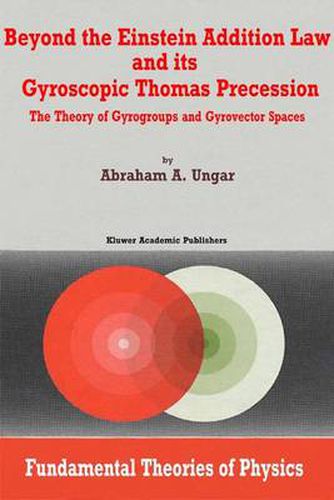Readings Newsletter
Become a Readings Member to make your shopping experience even easier.
Sign in or sign up for free!
You’re not far away from qualifying for FREE standard shipping within Australia
You’ve qualified for FREE standard shipping within Australia
The cart is loading…






This title is printed to order. This book may have been self-published. If so, we cannot guarantee the quality of the content. In the main most books will have gone through the editing process however some may not. We therefore suggest that you be aware of this before ordering this book. If in doubt check either the author or publisher’s details as we are unable to accept any returns unless they are faulty. Please contact us if you have any questions.
Evidence that Einstein’s addition is regulated by the Thomas precession has come to light, turning the notorious Thomas precession, previously considered the ugly duckling of special relativity theory, into the beautiful swan of gyrogroup and gyrovector space theory, where it has been extended by abstraction into an automorphism generator, called the Thomas gyration. The Thomas gyration, in turn, allows the introduction of vectors into hyperbolic geometry, where they are called gyrovectors, in such a way that Einstein’s velocity additions turns out to be a gyrovector addition. Einstein’s addition thus becomes a gyrocommutative, gyroassociative gyrogroup operation in the same way that ordinary vector addition is a commutative, associative group operation. Some gyrogroups of gyrovectors admit scalar multiplication, giving rise to gyrovector spaces in the same way that some groups of vectors that admit scalar multiplication give rise to vector spaces. Furthermore, gyrovector spaces form the setting for hyperbolic geometry in the same way that vector spaces form the setting for Euclidean geometry. In particular, the gyrovector space with gyrovector addition given by Einstein’s (Moebius’) addition forms the setting for the Beltrami (Poincare) ball model of hyperbolic geometry.
The gyrogroup-theoretic techniques developed in this book for use in relativity physics and in hyperbolic geometry allow one to solve old and new important problems in relativity physics. A case in point is Einstein’s 1905 view of the Lorentz length contraction, which was contradicted in 1959 by Penrose, Terrell and others. The application of gyrogroup-theoretic techniques clearly tilt the balance in favor of Einstein.
$9.00 standard shipping within Australia
FREE standard shipping within Australia for orders over $100.00
Express & International shipping calculated at checkout
This title is printed to order. This book may have been self-published. If so, we cannot guarantee the quality of the content. In the main most books will have gone through the editing process however some may not. We therefore suggest that you be aware of this before ordering this book. If in doubt check either the author or publisher’s details as we are unable to accept any returns unless they are faulty. Please contact us if you have any questions.
Evidence that Einstein’s addition is regulated by the Thomas precession has come to light, turning the notorious Thomas precession, previously considered the ugly duckling of special relativity theory, into the beautiful swan of gyrogroup and gyrovector space theory, where it has been extended by abstraction into an automorphism generator, called the Thomas gyration. The Thomas gyration, in turn, allows the introduction of vectors into hyperbolic geometry, where they are called gyrovectors, in such a way that Einstein’s velocity additions turns out to be a gyrovector addition. Einstein’s addition thus becomes a gyrocommutative, gyroassociative gyrogroup operation in the same way that ordinary vector addition is a commutative, associative group operation. Some gyrogroups of gyrovectors admit scalar multiplication, giving rise to gyrovector spaces in the same way that some groups of vectors that admit scalar multiplication give rise to vector spaces. Furthermore, gyrovector spaces form the setting for hyperbolic geometry in the same way that vector spaces form the setting for Euclidean geometry. In particular, the gyrovector space with gyrovector addition given by Einstein’s (Moebius’) addition forms the setting for the Beltrami (Poincare) ball model of hyperbolic geometry.
The gyrogroup-theoretic techniques developed in this book for use in relativity physics and in hyperbolic geometry allow one to solve old and new important problems in relativity physics. A case in point is Einstein’s 1905 view of the Lorentz length contraction, which was contradicted in 1959 by Penrose, Terrell and others. The application of gyrogroup-theoretic techniques clearly tilt the balance in favor of Einstein.